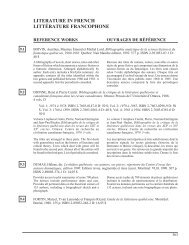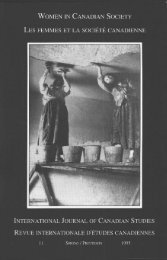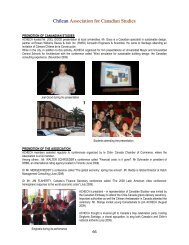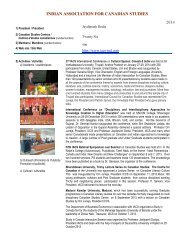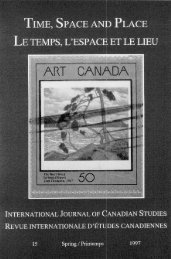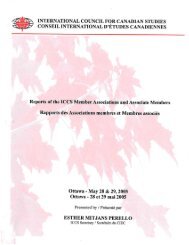Arts and Literature in Canada:Views from Abroad, Les arts et la ...
Arts and Literature in Canada:Views from Abroad, Les arts et la ...
Arts and Literature in Canada:Views from Abroad, Les arts et la ...
- No tags were found...
You also want an ePaper? Increase the reach of your titles
YUMPU automatically turns print PDFs into web optimized ePapers that Google loves.
IJCS/RIÉCTheir old colonial heritage <strong>and</strong> their new, marg<strong>in</strong>al situation lead theimmigrant writers to write as the “Other.” As Amitav Ghosh po<strong>in</strong>ts out, “Indiahas always been constituted as much by the notion of the periphery as it has bythe notion of the centre”; this notion of the periphery “has now exp<strong>and</strong>ed to<strong>in</strong>clude the diaspora” (78). 14 Such writers are both “hostage” <strong>and</strong>“representative,” <strong>and</strong> so are their protagonist/persona. However, they are notrepresentatives of the glories of newly won national freedom <strong>and</strong> national selfd<strong>et</strong>erm<strong>in</strong>ation.They cont<strong>in</strong>ue to speak <strong>from</strong> the marg<strong>in</strong>. In that sense, historyhas “always belonged to the colonizers, never to the colonized.” 15 Toarticu<strong>la</strong>te the past historically, as Walter Benjam<strong>in</strong> po<strong>in</strong>ts out, “does not meanto recognise it ‘the way it was.’ It means to seize hold of a memory as it f<strong>la</strong>shesup at a moment of danger.” 16 Hence, the immigrant writers’ focus is offcentred.Likewise, their protagonist/ persona hardly ever takes centre-stagebecause it is not “his-story” that is be<strong>in</strong>g re<strong>la</strong>ted. Instead, the narrative givesvoice to community life, to local or national politics, to the experience ofcolonialism. The quest-motif, which seems the arch<strong>et</strong>ypal pattern <strong>in</strong> theliterature of the predom<strong>in</strong>ant culture, <strong>and</strong> which is also conceived <strong>in</strong> terms of am<strong>et</strong>aphoric <strong>and</strong> som<strong>et</strong>imes an actual voyage, undergoes here a sea-change. AsArun Prabha Mukherjee po<strong>in</strong>ts out, the “artist-as-hero-creat<strong>in</strong>g-<strong>in</strong>-theiso<strong>la</strong>tion-of-hissoul” type of protagonist or the “connoisseur-of-chaos” typeof writer are nowhere to be seen. Here lies <strong>in</strong>stead, “an encounter with history<strong>and</strong> hence with one’s otherness” (48). 17 It would be relevant, at this juncture,to once aga<strong>in</strong> refer to The Gunnysack.Although the quest-motif gives this narrative its very be<strong>in</strong>g, The Gunnysackdoes not belong to the bildungsroman genre; the <strong>in</strong>dividual quest for selfhood<strong>and</strong> identity is rep<strong>la</strong>ced here by the quest for a collective, <strong>and</strong> communalidentity. The Afro-Asian community, an <strong>et</strong>hnic m<strong>in</strong>ority, forms the focus ofthis narrative. It was marg<strong>in</strong>alized first by the German s<strong>et</strong>tlers, then by theBritish colonialists <strong>and</strong> then by the native African of the “f<strong>la</strong>g <strong>in</strong>dependence”era. Nor does this narrative foreground the ma<strong>in</strong> chapters of history; ourattention is be<strong>in</strong>g drawn here to history’s foot-notes. Vassanji’s very choice ofnarrator is <strong>in</strong> keep<strong>in</strong>g with this low-keyed approach. Salim or Ka<strong>la</strong> the Afro-Asian, is literally <strong>and</strong> figuratively the b<strong>la</strong>ck sheep of the family <strong>and</strong> the secondsibl<strong>in</strong>g <strong>in</strong> every sense of that term. He is very much the Caliban figure, the darkother <strong>in</strong> Prospero’s k<strong>in</strong>gdom. Even as Salim opens the gunnysack to l<strong>et</strong> out itsmemories of the collective past, he modifies his own earlier comparison of thishomely, humble sack to Sheherazade, the compulsive story-teller of the exoticArabian Nights Tales. He states parenth<strong>et</strong>ically: “This drab gunnysack is nomore Sheherazade than I am Pr<strong>in</strong>ce Sheriyar. She is more your home-growntype, a local version, ... whom I name this <strong>in</strong>stant Sheherbanoo... SheherbanooSheherazade, how close <strong>in</strong> sound, y<strong>et</strong> worlds apart” (GS 5-6).The world that many immigrant writers have <strong>in</strong>itially explored has often beenthe world they have left beh<strong>in</strong>d rather than the world they have newly adopted.It is the old world that the new immigrants seem to <strong>in</strong>habit still <strong>and</strong> that appearsto <strong>in</strong>habit them. In Mistry’s conclud<strong>in</strong>g story “Swimm<strong>in</strong>g <strong>Les</strong>sons” (Tales...),90



